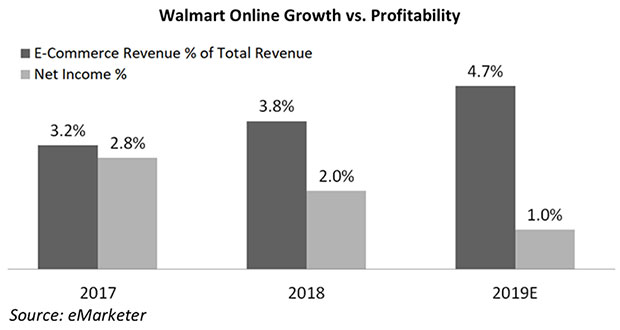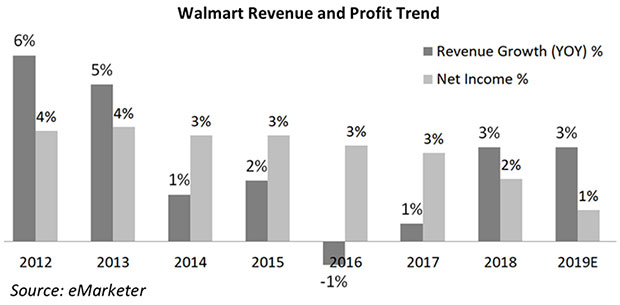Disruption drives business failure and success. Most people think technology drives disruption, but technology merely enables disruption — changing customer needs cause it. This is especially obvious in e-commerce. Amazon’s rapid growth and increased customer base got retailers worried. Leaders thought expanding their online presence would bring growth back — but they were wrong.
Consider Walmart. It changed the retail landscape in the 1990s — yet from 2012 to 2016, sales growth and profits steadily declined. Revenue growth declined from 6 percent in 2012 to -1 percent in 2016, while net income margin went from 4 percent to 3 percent.
From 2017 to 2019 (estimated), revenue increased from 1 percent to 3 percent, while net income declined from 3 percent to 1 percent. Thus, while Walmart did manage to grow sales, it grew them at the cost of profitability.

Instead of analyzing what the real problem was and trying to fix it, Walmart decided to seek new markets in e-commerce. It blamed Amazon for its declining revenue and customer dissatisfaction.
Although it did address some employee complaints and a few customer issues, it focused on expanding Walmart’s e-commerce, acquiring Jet.com in 2016 for US$3 billion. Later it bought brands such as Bonobos, Modcloth and Moosejaw.
Walmart also introduced free two-day shipping for online orders of $35 or more for 2 million items in Jan 2017 — but unlike Amazon Prime, access to the service didn’t require an annual fee. Not surprisingly, without subscriptions, this idea lost the company a lot of money.
Walmart did grow its online revenue as a percentage of total revenue from 2017 to 2019 (estimated) from 3.2 percent to 4.7 percent, but the profit margin declined rapidly from 2.8 percent to 1.0 percent. The exact impact of Walmart’s online sales increase on profitability is difficult to decipher. Nevertheless, it’s clear that e-commerce has not been a positive contributor to its bottom line.

Other retailers face similar challenges as they invest in e-commerce. Macy’s was a pioneer in digital transformation with its omnichannel strategy. Despite starting in 2010, Macy’s continues to struggle with revenue and profit, while TJX (parent company of TJ Maxx) and Inditex (parent company of Zara) are doing great.
Both TJX and Zara have limited online presence. TJ Maxx keeps its merchandise fresh and inexpensive by buying name brands at a discount; Zara’s supply chain gets catwalk fashion into stores quickly.
Failing to Deliver
Why are e-commerce strategies failing to deliver results? The answer is simple — the e-commerce strategies most retailers employ don’t address the root causes of their problems. Their strategies don’t address customers’ needs, so their customers go elsewhere.
When Walmart’s revenue dropped, it responded by cutting back on inventory and laying off staff. That made things even worse: Customers complained that they couldn’t find the products they wanted. The layoffs lowered morale, so employees refused to engage and answer simple questions from customers.
Industry analysts routinely reported that customers were complaining about Walmart’s poor selection, long checkout lines and bad customer service. It’s not Amazon or e-commerce that’s disrupting Walmart’s business; it’s customers. Going online instead of recognizing and fixing the problem will not increase revenue and profitability.
Similarly, Macy’s failure to grow its revenue and profit stems from the fact that customers have not been finding its merchandise attractive. TJ Maxx and Zara are addressing the customer need for affordability and fashion better than Macy’s. Both are extremely popular with customers.
Even Amazon is not invincible. Its 2016 market share was 1.3 percent of all online retail — down from its 2011 high. Meanwhile, Chinese e-commerce giants Alibaba and JD.com continue to hold a sizable market share.
How to Develop a Successful E-Commerce Strategy
In today’s world, an online presence is required for any merchant. However, having an e-commerce site doesn’t mean that customers automatically will start buying from the company. It’s just a channel to sell products to customers. The products and services have to meet customer needs. Following are a few steps that can help any company effectively design its e-commerce strategy.
- Step 1: Identify the targeted customer segment:
You can’t have the same strategy for all segments. Zalando, the European e-commerce company that sells shoes and clothing, shows the benefit of customizing e-commerce presence by country. Its payment methods and use of local brand are great successes. The ability to target each customer segment differently based on interests is the first step to this kind of success.
Yet most companies don’t identify their customer segments well. They segment customers according to psychographics and demographics. These may work for marketing and advertising, but not for targeting for services, because they don’t provide insights into buying behavior.
A better way is to segment the customer base by buying behavior that can be measured, such as usage or business metrics. For example, Amazon targeted frequent online shoppers with its Prime program, which grew sales and profit, while Walmart offered free shipping on all purchases over $35 and grew sales at the cost of profit. Thoughtfully identifying target segments helps companies grow profitably.
- Step 2: Identify customer needs of the targeted segment:
Understanding customers’ needs is the most crucial step in dealing with disruption — and many companies don’t try hard enough to reach that understanding. They focus on what their customers tell them they want.
As Steve Jobs said: “Some people say, ‘Give the customers what they want,’ but that’s not my approach. Our job is to figure out what they’re going to want before they do. I think Henry Ford once said, ‘If I’d asked customers what they wanted, they would have told me, ‘a faster horse!’ ‘People don’t know what they want until you show it to them. That’s why I never rely on market research. Our task is to read things that are not yet on the page.”
Generational changes must be part of this process. The younger generations have different needs. If companies want to stay in business, they need to figure out what Millennials and Gen Z want — which is different from what Boomers want.
For example, Millennials and Gen Z like style advisory. If a company is selling apparel online, style advisory is a must. Zalando, for instance, in its home country Germany, employs 150 fashion stylist who gives personal fashion advice through WhatsApp.
Whatever your business, you need to identify your customer segments and examine their needs. This process is more like a doctor diagnosing root causes of an illness rather than just prescribing medicines to address symptoms.
- Step 3: Develop strategies to meet those needs (online or offline):
Once a company has identified customer needs, then it has to figure out strategies to meet those needs. For an e-commerce company, service such as easy ordering and return are critical for customer acceptance.
Zalando has free delivery, and customers can return products for free within the first 100 days of purchase. Fifty percent of its products are returned, but the company has started turning profit much faster than Amazon.
As the e-commerce space gets crowded, companies have to figure out other ways of meeting customer needs. This could be through personalization, quality and other means. A careful study of customer needs in the targeted segment will reveal the appropriate strategies to follow. This shouldn’t be about one-upping others in the market, but about responding to and delivering on real customer needs.
- Step 4: Enable with technology:
The last step, not the first, is to use the right technology. Companies can choose to partner with existing e-commerce sites like Amazon, or develop a direct-to-customer site, or to do both.
Partnering with an e-commerce site provides quick access to visitors, but there are two big problems: first, loss of brand identity; and second, loss of customer information.
Some e-commerce sites are starting to address seller concerns. Zalando allows seller-branded stores on its site, like Adidas, Nike, Vans and others. This benefits both the sellers and Zalando.
Sellers can use different technologies to create an e-commerce site quickly. With woo-commerce and Magento (storefront software that works with most websites), even small businesses can have direct-to-customer e-commerce sites on their domains.
Laravel and .net provide easy ways to create custom storefronts. For established companies, going directto-customers may work out better in the long run, as it allows for developing a relationship with customers directly.
However, the cost of marketing and shipment may outweigh that benefit in the short term. Companies need to find a balance between developing a relationship with customers and growth through partnership with e-commerce sites. I expect there will be an increasing trend for direct-to-customers as customers benefit from personalized services and efficiencies.
Meeting Customer Needs Is Paramount
To be successful with e-commerce, companies will have to find ways to address customer needs. This is true for all businesses. Customers buy only if their needs are met. A step-by-step approach could help leaders find a better way to develop their e-commerce strategy.
The future for most companies will involve a more direct-to-customer approach as manufacturers/service providers start offering personalized services. Service aspects of e-commerce, such as free shipping and returns, will remain important. Still, whatever the future holds, unless manufacturers address customers’ emerging needs before carefully choosing the technology to deliver on those needs, their success will be limited.
Whatever technologies become available — and we can be sure a plethora will — customers will remain the real disruptors.















































Social Media
See all Social Media